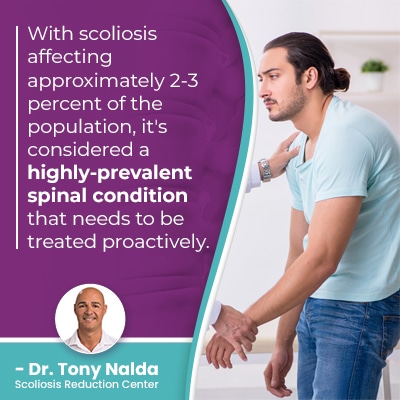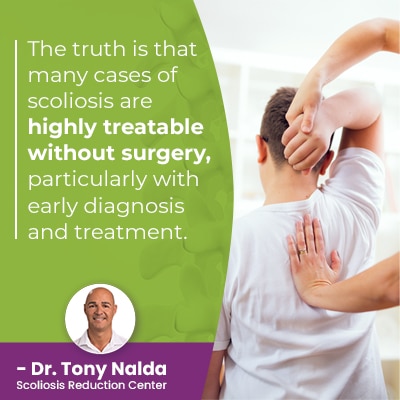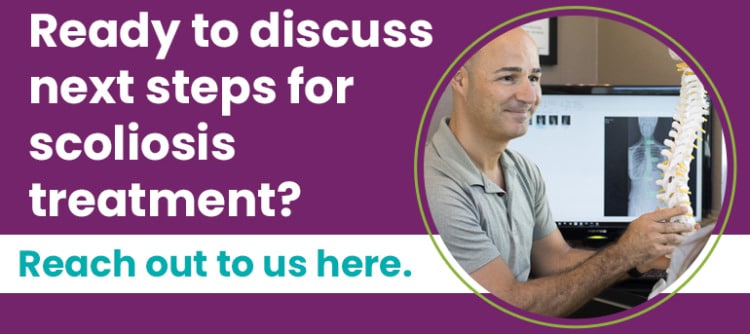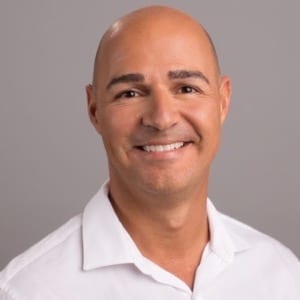Top 11 Surprising Scoliosis Statistics Explained

Scoliosis treatment has to be customized because no two cases are the same, and as a progressive condition, its nature is to get worse over time, making it more complex to treat. These top 11 surprising scoliosis facts can help with awareness.
Scoliosis is a complex spinal condition that has a number of interesting characteristics. From the many different types and wide-ranging severity levels, there is still a lot we don't fully understand about the condition.
Scoliosis affects all ages, but many would be surprised at just how prevalent the spinal condition is.
Understanding Scoliosis
Scoliosis causes the spine to bend and twist unnaturally. While there are a number of spinal conditions that involve the development of an unhealthy spinal curve, scoliosis is highly prevalent and has some unique characteristics that set it apart.
While scoliosis causes the spine to bend unnaturally to the side, it also causes the spine to rotate, making it a complex 3-dimensional condition, so effective treatment options have to address both the spine's unnatural bend and twist.
Scoliosis is also progressive in nature, so virtually all cases are going to increase in severity over time, hence the importance of a proactive treatment approach.
The most important thing to understand about scoliosis is that as a progressive condition, where a patient's condition is at the time of diagnosis doesn't mean that's where it will stay; only proactive treatment can work towards counteracting the condition's progressive nature.
1) Scoliosis is Highly Prevalent
The Scoliosis Research Society puts current estimates at close to seven million people living with the condition in the United States alone, and as the leading spinal condition among school-aged children, it warrants awareness.
As these estimates are based on known diagnosed cases in the States alone, if people living with scoliosis unaware could be tracked, that number would increase exponentially.
 With scoliosis affecting approximately 2-3 percent of the population, it's considered a highly-prevalent spinal condition that needs to be treated proactively.
With scoliosis affecting approximately 2-3 percent of the population, it's considered a highly-prevalent spinal condition that needs to be treated proactively.
2) Scoliosis is Progressive
Most people have heard of scoliosis and know it involves the spine, but many don't realize that as a progressive condition, it's virtually guaranteed to get worse over time.
Progression means the size and rotation of the unnatural spinal curvature is increasing, and as progression is triggered by growth, childhood scoliosis should always be taken seriously and treated proactively.
The more scoliosis progresses, the more complex it is to treat. The spine gets increasingly rigid alongside progression, making it less responsive.
3) Gender is a Risk Factor
Risk factors for scoliosis include age, family history, and gender.
It's estimated that females are 8 times more likely to develop scoliosis that continues to progress and requires intervention.
The higher scoliosis severity levels in females is thought to be related to the earlier start of puberty; remember, scoliosis progression is triggered by growth.
Cases of degenerative scoliosis that affect older adults are also more prevalent in females, and this is due to the changes in bone density and hormones that characterize menopause.
4) The Cause of Idiopathic Scoliosis Remains Unknown
Part of diagnosing scoliosis involves comprehensive assessment to further classify conditions based on key variables, one of which is condition type.
Condition type is determined by causation, and in the majority of scoliosis cases, approximately 80 percent, the cause is unknown.
Idiopathic scoliosis is the most common type of scoliosis to affect all ages, and while we don't know what triggers its initial onset, we know it's growth that triggers progression, and we know how to craft and apply effective treatment options.
5) The Most Common Age Group Affected are Adolescents
Scoliosis affects all ages from babies to elderly and every age in between, but the most prevalent type overall is adolescent idiopathic scoliosis diagnosed between the ages of 10 and reaching skeletal maturity.
Adolescent idiopathic scoliosis patients are also the most at risk for rapid=phase progression due to the stage of growth patients are in, or entering into: rapid and unpredictable growth spurts of puberty.
The rate of adolescents affected is approximately 1-3 percent.
6) Scoliosis Isn't Always Painful
Part of the reason scoliosis isn't always easy to diagnose is the lack of pain in childhood scoliosis.
While pain is the main symptom of adult scoliosis, as the condition doesn't become compressive until skeletal maturity has been reached, childhood scoliosis isn't commonly painful.
Compression is uneven pressure, and if the spine is no longer growing, it's compression of the spine and its surrounding muscles and nerves that causes the majority of condition-related pain.
Scoliosis pain can involve the muscles, back pain, and nerve pain that radiates into the extremities.
While pain management is a main focus of adult scoliosis treatment, counteracting progression during growth is a main focus of childhood scoliosis treatment.
7) Untreated Scoliosis Can Lead to Complications
While there are no treatment guarantees, there is a direct link between early detection, intervention, and treatment success.
As a progressive condition, leaving scoliosis untreated can be dangerous. While traditional treatment commonly recommends watching and waiting in mild cases, this is the best time to start treatment because the curve is at its smallest, most responsive, and significant progression hasn't yet occurred.
Leaving scoliosis untreated can mean allowing the unnatural spinal curve to progress unimpeded, and in severe scoliosis and/or atypical cases, complications can include breathing problems, cardiac and digestive issues.
In addition, the more severe a condition is, the more likely future surgery is, and spinal fusion surgery comes with its own share of serious risks, side effects, and potential complications.
8) The Cost of Spinal Fusion Surgery
While many factors affect the final cost of spinal fusion surgery, on average, the cost ranges between $80,000 and $175,000.
Factors that impact the final cost include condition severity, type, patient response, number of vertebrae fused, whether there are complications during the procedure, individual surgeon fees, length of surgery and recovery time spent in hospital.
It's also important to understand that spinal fusion surgery comes with more than just a monetary cost; many patients experience an increase in back pain and a noticeable loss in spinal flexibility and range of motion that can affect quality of life.
In addition, a fused spine is fused for life and is weaker and more vulnerable to injury.
It's estimated that approximately 38,000 scoliosis patients undergo invasive spinal fusion annually.
9) Many Cases of Scoliosis Don't Need Surgery
 The truth is that many cases of scoliosis are highly treatable without surgery, particularly with early diagnosis and treatment.
The truth is that many cases of scoliosis are highly treatable without surgery, particularly with early diagnosis and treatment.
When conservative non-surgical scoliosis treatment is applied immediately following a diagnosis, there are fewer limits to what can be achieved.
Conservative treatment is integrative and combines the power of chiropractic care, physical therapy, corrective bracing, and rehabilitation.
10) Scoliosis Screening Can Lead to Early Diagnosis
There was a time when mandatory scoliosis screening was conducted in schools across the United States, but that has since changed, shifting the onus of early detection onto parents, caregivers, and patients themselves.
Scoliosis screening examinations are particularly important for those with a family history.
Early diagnosis doesn't guarantee treatment success, but it does increase the likelihood.
11) Scoliosis Bracing
As growing spines are more malleable, scoliosis bracing is a regular facet of treatment for scoliosis and can help by pushing the spine into a corrective position.
According to Columbia University, approximately 30,000 children are fitted for a scoliosis brace annually.
Conclusion
Perhaps the most surprising fact about scoliosis is that despite its prevalence, we still don't fully understand why most cases develop, but what we do understand is how to treat conditions effectively.
We know it's growth that triggers progression, so a focus of childhood scoliosis treatment is on counteracting progression despite the constant trigger of growth occurring.
Bad posture can contribute to an unhealthy spinal curvature, but as a structural spinal condition, scoliosis has to be primarily impacted on a structural level, and the earlier treatment is started, the more successful non-surgical treatment options are.
When condition-specific chiropractic care, physical therapy, corrective bracing, and rehabilitation are combined and integrated into a proactive treatment plan, progression can be prevented and curves can be reduced.
By reducing the unhealthy spinal curvature, as much of the spine's healthy curves as possible are being restored, and this means a spine that's balanced and stable, which extends to a body that's balanced and stable.
Although scoliosis is a common spinal condition, it has some unique characteristics that can make it particularly challenging to treat, including its different types, severity levels, curvature types and locations, and its 3-dimensional progressive nature.
Here at the Scoliosis Reduction Center®, patients benefit from a proactive conservative treatment approach that's started as close to the time of diagnosis as possible
Dr. Tony Nalda
DOCTOR OF CHIROPRACTIC
After receiving an undergraduate degree in psychology and his Doctorate of Chiropractic from Life University, Dr. Nalda settled in Celebration, Florida and proceeded to build one of Central Florida’s most successful chiropractic clinics.
His experience with patients suffering from scoliosis, and the confusion and frustration they faced, led him to seek a specialty in scoliosis care. In 2006 he completed his Intensive Care Certification from CLEAR Institute, a leading scoliosis educational and certification center.
About Dr. Tony Nalda
 Ready to explore scoliosis treatment? Contact Us Now
Ready to explore scoliosis treatment? Contact Us Now





